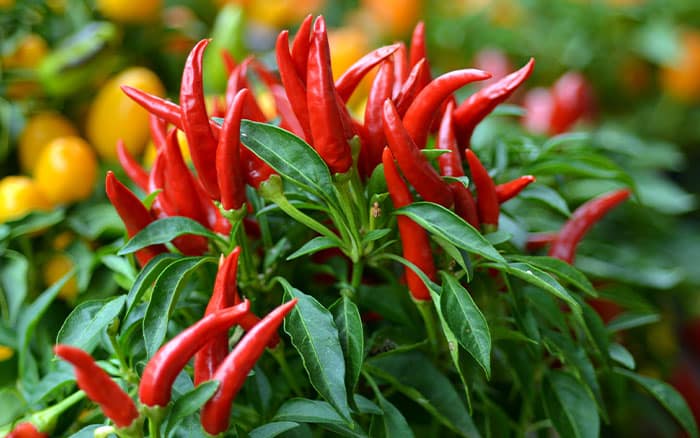I’ve received a lot of amazing questions on my social media platforms lately. So I have filmed a video answering a few of them! The video is below, but you can also find the questions and answers here.
At what point do you prune a chilli plant?
Chillis are great, I grow mine in the greenhouse. I love Apache chillies, and they make for a lovely garnish on a pizza.
They grow in a tight bush which means it doesn’t take up too much space and is easy to maintain.
To encourage side shoots, which should carry more fruit, pinch out the shoot tips once the plant reaches 30cm (1ft) tall. When you pinch out the tip, it becomes bushier and fuller.

How often should we replace the soil in garden pots?
Eventually, container plants need to be moved to a bigger pot, which should be done in early spring.
You usually have about 3 months’ worth of usable food for your plant in your compost.
To add fresh compost to your container, first remove a little of the old compost.
Then. replace ⅓ of the existing compost with fresh.
When repotting isn’t required, remove 5cm of old compost from the top, and replace it with fresh

How far back can you cut a hedge?
If tidying an overgrown deciduous or evergreen hedge you can cut the height and width back by 50% in one cut.
It’s best to stagger this process over the course of two years.
Don’t allow hedges to become wider at the top than they are at the base, this will result in poor growth and bare patches.
Avoid trimming during bird nesting times, so in early spring, as this will let them settle in to look after their eggs and hatchlings
Deciduous and evergreen hedges do sometimes require slightly different treatment.
If it is an evergreen hedge, don’t trim too far back into the dry, dead foliage in the centre of the plant.

I was told you should never feed a wisteria, is this true?
I’m afraid this is about as true as the number of spots on a ladybird telling you how old it is. It’s not true, you can feed your wisteria!
Feed monthly with a high potash fertiliser during the growing season, to encourage more flowers to bloom.
Water and feed pot-grown wisteria weekly.
And in autumn, mulch with organic matter, like well-rotted horse manure or homemade compost.

Which flowers thrive in windy gardens?
Tip
Create a living windbreak by planting a hedge that faces the prevailing wind. This will reduce wind speed.
Brachyglottis compacta ‘Sunshine’ – This plant is tolerant of drought and salty winds, which is ideal for coastal gardens.
Crataegus monogyna (Hawthorn) – Producing lovely white flowers in May, Hawthorn is great as hedging. It creates an attractive wind barrier for your space.
Erysimum ‘Bowles’s Mauve’ – These wallflowers bloom from summer to autumn. Bees love these, which is perfect for a pollinator-friendly space.
Nepeta cataria ‘Catmint’ – This is large and hardy, which is an ideal wind-proof choice.


This is caused by a fungus, leading to reddening and twisting of the leaves.
Try to keep the shoots dry. Where peaches are grown trained against a fence or wall, a rain shelter of a plastic sheet is effective at preventing infection.
Cover the top of the tree and front within 30cm of the ground, with ends open to allow access for pollinating insects.
Put this up in November and remove in mid-May.
Prompt removal of infected leaves before the bloom of white spore appear will help reduce the fungus in the following year. Dispose of the leaves, don’t compost them.

What are the easiest vegetables to grow?
The following plants are all low easy, low-maintenance vegetables to try growing at home:
- Courgettes, squashes
- Beetroot
- Dwarf French beans
- Potatoes – in the ground, dustbin. You can even grow them in a compost bag.
- Radishes
- Shallots
- Rhubarb




Should I plant in containers, raised beds, or in the ground?
This really depends on what you would like to grow.
Raised beds are a good option if you’ve got limited mobility, so you could always choose this for whatever you want to grow for easier accessibility.
A good rule of thumb is as follows:
- Vegetables = Raised beds
- Berries = Containers
- Root Vegetables = In the ground



When’s the best time to prune apple trees?
Winter pruning, is best between November and March.
This is more for established apple bush trees or standard and half-standard trees.
Cut any dead, diseased, and damaged wood. Usually this starts four/five years after planting.
Routine winter pruning should remove about 10-20% of the canopy.
Prune into a wine glass shape.

What are your favourite cheap, low-maintenance plants?
Perennial bulbs that flower every year, and only need planting once. Some great options of these include:
- Spring: Crocus, Daffodil, Tulip, Lily of the Valley, Hyacinths
- Summer: Allium, Begonia, Freesia, Dahlia, Bearded Iris
Lavender and rosemary are also wonderful options – they only require trimming annually in late summer.
Viburnum x Burkwoodii is a wonderful shrub option being slow-growing, semi-evergreen. Prune in late spring if required.
Try planting in containers and raised beds to allow easier access.




Leave A Comment